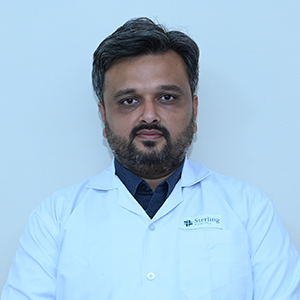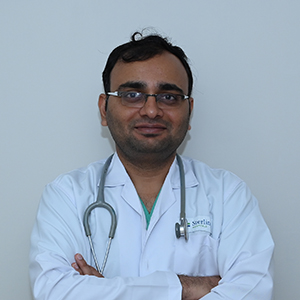Spine Surgery
The Department of Spine Surgery at Sterling Hospitals Rajkot is a specialized department that focuses on the diagnosis, treatment, and management of conditions related to the spine. This department is equipped with advanced facilities and a team of experienced spine surgeons who provide comprehensive care for patients with various spine-related disorders.
The department offers a wide range of services, including both surgical and non-surgical treatments for conditions such as degenerative disc disease, herniated disc, spinal stenosis, scoliosis, spondylolisthesis, spinal tumors, spine trauma, and other spine-related disorders. The team of spine surgeons utilizes advanced diagnostic techniques, including imaging studies such as X-rays, MRI, CT scans, and nerve conduction studies, to accurately diagnose spine conditions and develop personalized treatment plans.
The department is well-equipped with state-of-the-art operating rooms and advanced surgical instruments for performing a wide range of spine surgeries, including minimally invasive spine surgery, complex spinal reconstruction, spinal fusion, disc replacement surgery, and spinal deformity correction surgeries. The team of spine surgeons is skilled in utilizing advanced techniques and technologies, such as intraoperative monitoring, endoscopic spine surgery, to provide the best possible outcomes for patients undergoing spine surgery.
Apart from surgical interventions, the department also offers non-surgical treatment options such as physiotherapy, pain management, and rehabilitation programs for patients who may not require surgery or as part of their post-operative care.
The Department of Spine Surgery at Sterling Hospitals Rajkot is committed to providing comprehensive, patient-centered care for individuals with spine-related conditions. The department follows evidence-based practices, focuses on minimizing risks and complications, and ensures optimal patient outcomes. The team of spine surgeons works closely with other specialties, such as neurology, orthopedics, and physiotherapy, to provide a multidisciplinary approach to patient care and promote overall spine health.
There are several common spine diseases that can affect the health and function of the spine. These may include:
-
Degenerative Disc Disease: This is a condition where the discs between the vertebrae in the spine break down, leading to pain, stiffness, and reduced mobility.
-
Herniated Disc: Also known as a slipped or ruptured disc, this occurs when the inner portion of a spinal disc protrudes through the outer layer, causing pressure on nearby nerves and resulting in pain, numbness, and weakness in the affected area.
-
Spinal Stenosis: This condition is characterized by the narrowing of the spinal canal or nerve root canals, leading to compression of the spinal cord or nerves, causing pain, tingling, and weakness in the back, neck, arms, or legs.
-
Spondylolisthesis: This is a condition where one vertebra slips forward or backward in relation to the adjacent vertebra, resulting in pain, instability, and nerve compression.
-
Spinal Fractures: Fractures of the vertebrae can occur due to trauma, osteoporosis, or other conditions, resulting in pain, instability, and potential nerve damage.
-
Spinal Infections: Infections of the spine, such as spinal osteomyelitis or discitis, can result in pain, inflammation, and potential damage to the spinal structures.
-
Spinal Tumors: Tumors that develop in or around the spine, whether benign or malignant, can cause pain, nerve compression, and other symptoms.
-
Ankylosing Spondylitis: This is a type of inflammatory arthritis that primarily affects the spine, leading to inflammation, stiffness, and fusion of the vertebrae, resulting in reduced mobility and deformity.
-
Sciatica: Sciatica is a condition characterized by pain, tingling, and numbness that radiates from the lower back down the leg, often caused by compression of the sciatic nerve in the spine.
-
Radiculopathy: Radiculopathy refers to nerve root compression in the spine, commonly caused by conditions such as herniated discs, spinal stenosis, or spondylolisthesis, resulting in pain, weakness, and numbness along the path of the affected nerve.
It's important to note that the diagnosis and treatment of spine diseases should be done by a qualified healthcare professional specializing in spine care, as each condition may require specific medical or surgical interventions tailored to the individual patient's needs.
Inflammatory Spinal Conditions
Inflammatory spinal conditions can include conditions such as ankylosing spondylitis, rheumatoid arthritis, psoriatic arthritis, and reactive arthritis. These conditions typically involve inflammation of the spinal joints, ligaments, and/or discs, leading to pain, swelling, and stiffness in the spine. Inflammatory spinal conditions are often chronic and may require long-term management.
Treatment: The treatment of inflammatory spinal conditions may involve a combination of medical, conservative, and surgical approaches, depending on the severity and progression of the condition. The goal of treatment is to relieve pain, reduce inflammation, improve mobility, and prevent or manage complications. Treatment options may include:
-
Medications: Nonsteroidal anti-inflammatory drugs (NSAIDs) are commonly prescribed to reduce inflammation and relieve pain. Disease-modifying antirheumatic drugs (DMARDs) may also be used to suppress the immune system and slow down the progression of the condition.
-
Physical therapy: Physical therapy may be recommended to improve flexibility, strength, and mobility of the spine. This may involve exercises, stretches, and other techniques to improve posture and reduce pain.
-
Lifestyle changes: Lifestyle modifications such as maintaining good posture, regular exercise, and avoiding smoking may be recommended to manage symptoms and improve overall spine health.
-
Biologics: Biologic medications may be used in some cases to specifically target the inflammatory process and reduce symptoms.
-
Surgical interventions: In some cases, surgical intervention may be necessary for severe cases or if conservative treatments are not effective. Surgical options may include joint replacements, spinal fusion, and decompression surgeries to relieve pressure on the nerves.
Recovery: Recovery from inflammatory spinal conditions can vary depending on the severity of the condition, the effectiveness of the treatment, and the individual patient's response. It may take time to manage pain, inflammation, and improve mobility. Physical therapy and regular exercise may play a crucial role in the recovery process by strengthening the muscles around the spine and improving overall spine health. Compliance with medication and lifestyle modifications may also be important for long-term management and preventing disease progression.
In conclusion, inflammatory spinal conditions are chronic conditions that require specialized treatment for effective management. A multidisciplinary approach involving medications, physical therapy, lifestyle modifications, and surgical interventions may be used to relieve pain, reduce inflammation, and improve mobility. Recovery may take time and require ongoing management, and it is important to work closely with a healthcare provider to develop a personalized treatment plan for optimal outcomes.
Herniated Disc: Overview, Treatment, and Recovery
A herniated disc, also known as a slipped or ruptured disc, is a common condition that can cause significant pain and discomfort. At Sterling Hospitals, we specialize in the diagnosis and treatment of various spine conditions, including herniated discs, using advanced techniques and a comprehensive approach to patient care.
A herniated disc occurs when the inner portion of a spinal disc protrudes through the outer layer, often due to wear and tear or injury. This can result in pressure on nearby nerves, leading to pain, numbness, tingling, and weakness in the affected area. Herniated discs most commonly occur in the lower back (lumbar spine) or neck (cervical spine) regions, but can also affect the middle back (thoracic spine).
Treatment: The treatment of a herniated disc depends on the severity of the condition and the symptoms experienced by the patient. In many cases, conservative, non-surgical treatments are effective in relieving pain and promoting healing. These may include:
-
Medications: Nonsteroidal anti-inflammatory drugs (NSAIDs), pain relievers, and muscle relaxants may be prescribed to manage pain and inflammation.
-
Physical Therapy: Targeted exercises, stretching, and other physical therapy techniques can help improve strength, flexibility, and posture, and reduce pain.
-
Epidural Steroid Injections: Corticosteroid injections may be administered into the epidural space around the affected nerve to reduce inflammation and alleviate pain.
-
Lifestyle Modifications: Changes in lifestyle, such as maintaining proper posture, avoiding heavy lifting, and staying physically active, may be recommended to reduce strain on the spine and promote healing.
In some cases, when conservative treatments do not provide adequate relief, or if the herniated disc is causing severe symptoms or nerve damage, surgical intervention may be necessary. Surgical options may include:
-
Microdiscectomy: This minimally invasive procedure involves removing the portion of the herniated disc that is pressing on the nerve, while preserving the rest of the disc.
-
Laminectomy: This procedure involves removing a portion of the vertebra (lamina) to relieve pressure on the nerve.
-
Spinal Fusion: In cases where there is instability or multiple herniated discs, spinal fusion may be performed to fuse two or more vertebrae together to stabilize the spine.
Recovery: Recovery from a herniated disc varies depending on the severity of the condition, the type of treatment received, and individual factors. In many cases, conservative treatments and minimally invasive surgical procedures can lead to significant pain relief and improved function. Patients may be advised to gradually resume normal activities, with specific instructions on lifting, bending, and posture to avoid re-injury. Physical therapy may be recommended to improve strength, flexibility, and posture, and to prevent recurrence of the herniated disc. It's important to follow the recommended treatment plan and adhere to post-operative instructions provided by the healthcare team to achieve optimal recovery.
At Sterling Hospitals, our experienced team of spine specialists is committed to providing comprehensive and personalized care for patients with herniated discs and other spine conditions. We offer a range of advanced diagnostic and treatment options, including conservative and surgical interventions, tailored to each patient's unique needs. Our goal is to relieve pain, improve function, and help patients achieve a successful recovery, so they can get back to their daily activities with improved quality of life.
Sciatica
Sciatica is a common condition that affects the sciatic nerve, which is the longest nerve in the body. It can cause pain, numbness, tingling, and weakness that radiates from the lower back down through the buttock and into the leg. At Sterling Hospitals, we provide comprehensive care for patients with sciatica, offering advanced diagnostic and treatment options to relieve pain and improve function.
Sciatica is usually caused by compression or irritation of the sciatic nerve, often due to a herniated disc, bone spur, or narrowing of the spinal canal (spinal stenosis). Other factors such as muscle imbalances, trauma, and degenerative changes in the spine can also contribute to the development of sciatica.
Treatment: The treatment of sciatica depends on the severity of the condition, the underlying cause, and the symptoms experienced by the patient. Conservative, non-surgical treatments are typically the first line of management and may include:
-
Medications: Nonsteroidal anti-inflammatory drugs (NSAIDs), pain relievers, and muscle relaxants may be prescribed to manage pain and inflammation associated with sciatica.
-
Physical Therapy: Targeted exercises, stretching, and other physical therapy techniques can help improve strength, flexibility, and posture, and relieve pressure on the sciatic nerve.
-
Epidural Steroid Injections: Corticosteroid injections may be administered into the epidural space around the affected nerve to reduce inflammation and alleviate pain.
-
Lifestyle Modifications: Changes in lifestyle, such as maintaining proper posture, avoiding prolonged sitting or standing, and using ergonomic furniture, may be recommended to reduce strain on the spine and relieve sciatica symptoms.
In cases where conservative treatments do not provide adequate relief, or if the sciatica is causing severe symptoms or nerve damage, surgical intervention may be considered. Surgical options for sciatica may include:
-
Microdiscectomy: This minimally invasive procedure involves removing the portion of the herniated disc or bone spur that is compressing the sciatic nerve, while preserving the rest of the disc.
-
Laminectomy: This procedure involves removing a portion of the vertebra (lamina) to relieve pressure on the sciatic nerve.
-
Spinal Fusion: In cases where there is instability or spinal stenosis, spinal fusion may be performed to stabilize the spine and relieve pressure on the sciatic nerve.
Recovery: Recovery from sciatica depends on various factors, including the severity of the condition, the type of treatment received, and individual factors. In many cases, conservative treatments or minimally invasive surgical procedures can lead to significant pain relief and improved function. Patients may be advised to gradually resume normal activities, with specific instructions on lifting, bending, and posture to avoid re-injury. Physical therapy may be recommended to improve strength, flexibility, and posture, and to prevent recurrence of sciatica.
At Sterling Hospitals, our experienced team of spine specialists is dedicated to providing comprehensive care for patients with sciatica. We offer advanced diagnostic and treatment options, including conservative and surgical interventions, tailored to each patient's unique needs. Our goal is to relieve pain, improve function, and help patients achieve a successful recovery, so they can regain their quality of life. If you are experiencing symptoms of sciatica, our expert team is ready to provide you with personalized care to effectively manage your condition and improve your well-being.
Endoscopic/ Minimally Invasive Spine Surgery
Endoscopic spine surgeries are minimally invasive procedures that utilize specialized instruments and advanced imaging technology to treat various spine conditions with smaller incisions and reduced tissue damage compared to traditional open surgeries. At Sterling Hospitals , our experienced spine surgeons are skilled in performing endoscopic spine surgeries, providing patients with several benefits, including faster recovery times, less pain, and reduced scarring.
Endoscopic spine surgeries involve the use of a small tube-like instrument with a light source and a camera (endoscope) that is inserted through a small incision in the skin to access the affected area of the spine. The camera provides real-time images, allowing the surgeon to visualize the spine and perform the surgery with precision. Endoscopic spine surgeries can be used to treat a wide range of conditions, including herniated discs, spinal stenosis, degenerative disc disease, and nerve impingements.
Treatment: Endoscopic spine surgeries can be used to perform various procedures, depending on the specific condition and location of the spine. Some common endoscopic spine surgeries performed at Sterling Hospitals Rajkot include:
-
Endoscopic Discectomy: This procedure involves removing a herniated disc or disc fragments that are compressing the nerves, causing pain and other symptoms.
-
Endoscopic Foraminotomy: This procedure involves removing bone spurs or other obstructions from the neural foramina, the openings through which nerves exit the spine, to relieve nerve compression.
-
Endoscopic Facet Rhizotomy: This procedure involves using a laser or other tools to selectively denervate the facet joints, which can help alleviate pain caused by arthritis or other degenerative conditions of the spine.
-
Endoscopic Spinal Fusion: This procedure involves stabilizing the spine by fusing two or more vertebrae together using endoscopic techniques, often with the use of specialized implants.
Recovery: One of the significant benefits of endoscopic spine surgeries is the faster recovery times compared to traditional open surgeries. Since the incisions are smaller, there is less tissue damage, resulting in less postoperative pain and quicker healing. Most patients can expect to have a shorter hospital stay and a faster return to their normal activities compared to open surgeries. However, the recovery process can vary depending on the individual, the extent of the surgery, and the specific condition being treated. Patients will be provided with postoperative care instructions, including restrictions on activities such as lifting, bending, and twisting, as well as rehabilitation exercises to improve strength and flexibility.
Endoscopic spine surgeries are advanced and minimally invasive procedures that offer several benefits for patients with various spine conditions. At Sterling Hospitals , our skilled spine surgeons are experienced in performing endoscopic spine surgeries, providing patients with effective treatment options with faster recovery times and improved outcomes. If you are suffering from spine-related pain or discomfort, our expert team can evaluate your condition and recommend the most appropriate treatment approach, including endoscopic spine surgery, to help you achieve relief and improve your quality of life.













